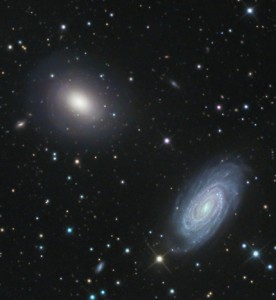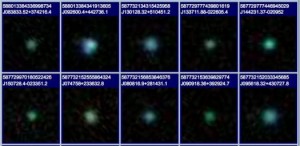
In 2007, the Galaxy Zooites — 100,000 housewives, high school students, helicopter pilots, physicians, school teachers, truck drivers, secretaries, and a mobile home park manager from all over the world – got together on the internet under the guidance of some astronomers and classified galaxies. Galaxies tend to be either spirals or ellipticals, computers are lousy at identifying shapes, humans are superb at it. So the Zooites look at a picture of a galaxy, click “spiral,” next picture, click “elliptical,” and so on for a gazillion galaxies. Toward the end of the year, one Zooite posted to the forum a picture of small, round, green galaxy. Round or elliptical galaxies are huge and almost always reddish. Spiral galaxies are less huge but still large and almost always bluish. Galaxies that are small are almost never round and certainly not green.

By July, 2008, the Zooites had found enough of these galaxies they were now calling Green Peas – their slogan, Give Peas a Chance! – that astronomers were getting seriously interested. So astronomers did what they always do with a new project, they gave it to a graduate student, this one named Carie. Carie asked the Zooites to do a systematic search for very green, compact galaxies with a big bright OIII line in the r-band of the spectrum – mind you, Carie’s talking to housewives here but the housewives have, after time on Galaxy Zoo, given themselves a serious astronomical education and are expert with OIII lines. When they’d found 251 Green Peas, Carie and others published a scientific paper: Peas were a hundredth the size of the Milky Way — a normal galaxy — and forming stars ten times faster.
Then some other astronomers got interested in the Peas – Green Peas is now the official astronomical name – and found they were metal-poor, meaning that they’re made only of the two elements the universe began with, hydrogen and helium. That’s odd because normal galaxies at the Peas’ distances are full of elements like carbon and iron and nickel that were made in stars as the universe got older. So Carie got time on a giant radio telescope to look at the Peas in more detail, because she thinks the Green Peas look like some of the first galaxies formed, very far away, very far back when the universe was still young. These baby galaxies, called Lyman Break Galaxies, are effectively too far away to study. Carie thinks studying the Green Peas might help understand the Lyman Breaks and therefore the history of the universe. She explained all this in a blog to the Zooites. Zooite Rick wrote back, “Beyond awesome! Best of luck!”
Amazing how astronomy gets done these days, and by whom.
Photo credits:
Galaxies: copyright by and used with permission from Giovanni Benintende
Green Peas: Sloan Digital Sky Survey
I heard you today on the bob edwards show. I had a cosmology course in college in the ’60s, and was fascinatedb with what you were talking about. Now this blog entry makes me think olf what I read of in clay shirkey’s book on the questioning of authorities/downfall of authorities in the age of the internet.
I haven’t heard that Bob Edwards show yet, but you’re reassuring me. Nor have I read Shirkey, but something about those Zooites & their willingness to go where only astronomers have trod makes me suspect you’re right.
Someone just told me about the Green Peas but I thought it was a joke. I googled it and found this post.”Give peas a chance” – gotta love it. Glad astronomers have a sense of humor. Fascinating stuff!
I’m thinking it wasn’t the astronomers who said “Give peas a chance,” it was those redoubtable Zooites. I’m glad you love it — I do too.
Give peas a chance is a variation of John Lennon. Amazing that astronomers can crack a joke like that!
What an interesting post. Its amazing how vast and unknown space is. Thanks for sharing this post.